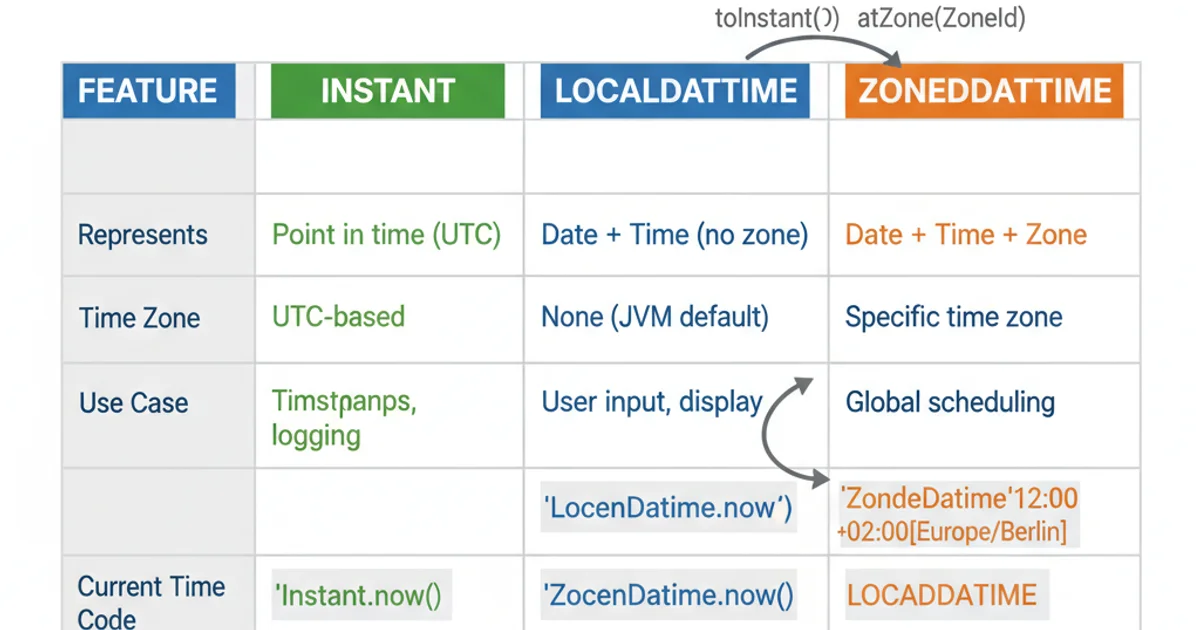How to get the current date and time
Categories:
Mastering Date and Time in Java: A Comprehensive Guide

Learn how to accurately retrieve and manipulate the current date and time in Java using both legacy java.util.Date and modern java.time APIs.
Working with dates and times is a fundamental requirement in almost any application. Whether you're logging events, scheduling tasks, or displaying timestamps to users, knowing how to correctly obtain the current date and time in Java is crucial. This article explores the various approaches, from the older java.util.Date and Calendar classes to the more robust and user-friendly java.time package introduced in Java 8.
The Modern Approach: java.time Package (Java 8+)
Introduced in Java 8, the java.time package (also known as JSR-310) provides a comprehensive and immutable API for date and time manipulation. It addresses many of the shortcomings of the legacy Date and Calendar classes, offering better clarity, thread-safety, and functionality. This is the recommended approach for all new Java development.
flowchart TD
A[Start] --> B{"Need current time?"}
B -->|Yes| C[Instant.now() for UTC]
B -->|Yes| D[LocalDateTime.now() for local date/time]
B -->|Yes| E[ZonedDateTime.now() for zoned date/time]
C --> F[Format as needed]
D --> F
E --> F
F --> G[End]Flowchart for obtaining current date and time using java.time
import java.time.Instant;
import java.time.LocalDateTime;
import java.time.ZonedDateTime;
import java.time.ZoneId;
import java.time.format.DateTimeFormatter;
public class ModernDateTime {
public static void main(String[] args) {
// 1. Current Instant (UTC/GMT time-stamp)
Instant currentInstant = Instant.now();
System.out.println("Current Instant (UTC): " + currentInstant);
// 2. Current Local Date and Time (without time-zone information)
LocalDateTime currentLocalDateTime = LocalDateTime.now();
System.out.println("Current Local Date/Time: " + currentLocalDateTime);
// 3. Current Zoned Date and Time (with time-zone information)
ZonedDateTime currentZonedDateTime = ZonedDateTime.now();
System.out.println("Current Zoned Date/Time (System Default): " + currentZonedDateTime);
// Get current date/time in a specific time zone
ZoneId newYorkZone = ZoneId.of("America/New_York");
ZonedDateTime newYorkDateTime = ZonedDateTime.now(newYorkZone);
System.out.println("Current Zoned Date/Time (New York): " + newYorkDateTime);
// Formatting the output
DateTimeFormatter formatter = DateTimeFormatter.ofPattern("yyyy-MM-dd HH:mm:ss");
String formattedDateTime = currentLocalDateTime.format(formatter);
System.out.println("Formatted Local Date/Time: " + formattedDateTime);
}
}
Examples of getting current date and time using java.time classes.
java.time for new development. Its immutability and clear separation of concerns (instant, local, zoned) make it less error-prone and easier to reason about.The Legacy Approach: java.util.Date and java.util.Calendar
Before Java 8, developers primarily used java.util.Date and java.util.Calendar to handle dates and times. While still functional, these classes have several design flaws, including mutability, non-thread-safety, and a confusing API (e.g., Date objects actually represent an instant in time, not a 'date' in the calendar sense). You might encounter these in older codebases.
import java.util.Date;
import java.util.Calendar;
import java.text.SimpleDateFormat;
public class LegacyDateTime {
public static void main(String[] args) {
// 1. Getting current Date using java.util.Date
Date currentDate = new Date();
System.out.println("Current Date (java.util.Date): " + currentDate);
// 2. Getting current Date and Time using java.util.Calendar
Calendar calendar = Calendar.getInstance(); // Gets a calendar using the default time zone and locale
Date calendarDate = calendar.getTime();
System.out.println("Current Date (java.util.Calendar): " + calendarDate);
// Formatting the output using SimpleDateFormat
SimpleDateFormat sdf = new SimpleDateFormat("yyyy-MM-dd HH:mm:ss");
String formattedDate = sdf.format(currentDate);
System.out.println("Formatted Legacy Date: " + formattedDate);
// Setting a specific time zone for Calendar
calendar.setTimeZone(java.util.TimeZone.getTimeZone("America/Los_Angeles"));
Date laDate = calendar.getTime();
System.out.println("Current Date (LA TimeZone via Calendar): " + laDate);
}
}
Examples of getting current date and time using legacy java.util.Date and Calendar.
java.util.Date and Calendar. They are mutable and not thread-safe, which can lead to unexpected behavior in concurrent environments. If you must interact with legacy APIs, consider converting to java.time objects as soon as possible using Date.toInstant() or Calendar.toInstant().Choosing the Right Class for Your Needs
The choice of which class to use depends on your specific requirements:
Instant: Use when you need a timestamp representing a point on the timeline in UTC. Ideal for logging, database storage, or any scenario where time zone is irrelevant at the point of capture.LocalDateTime: Use when you need a date and time without any time zone information. This is useful for representing a date and time that is common across all locations (e.g., 'Christmas Day 2024 at 10 AM') or when the time zone is handled separately.ZonedDateTime: Use when you need a complete date, time, and time zone. This is essential for user-facing applications where the exact time in a specific geographical region matters.LocalDate: If you only need the date part (year, month, day) without time.LocalTime: If you only need the time part (hour, minute, second, nanosecond) without date.
Understanding these distinctions will help you avoid common pitfalls related to time zone conversions and daylight saving time.

Comparison of key java.time classes for current date/time.
java.time.format.DateTimeFormatter is the modern, thread-safe alternative to java.text.SimpleDateFormat.